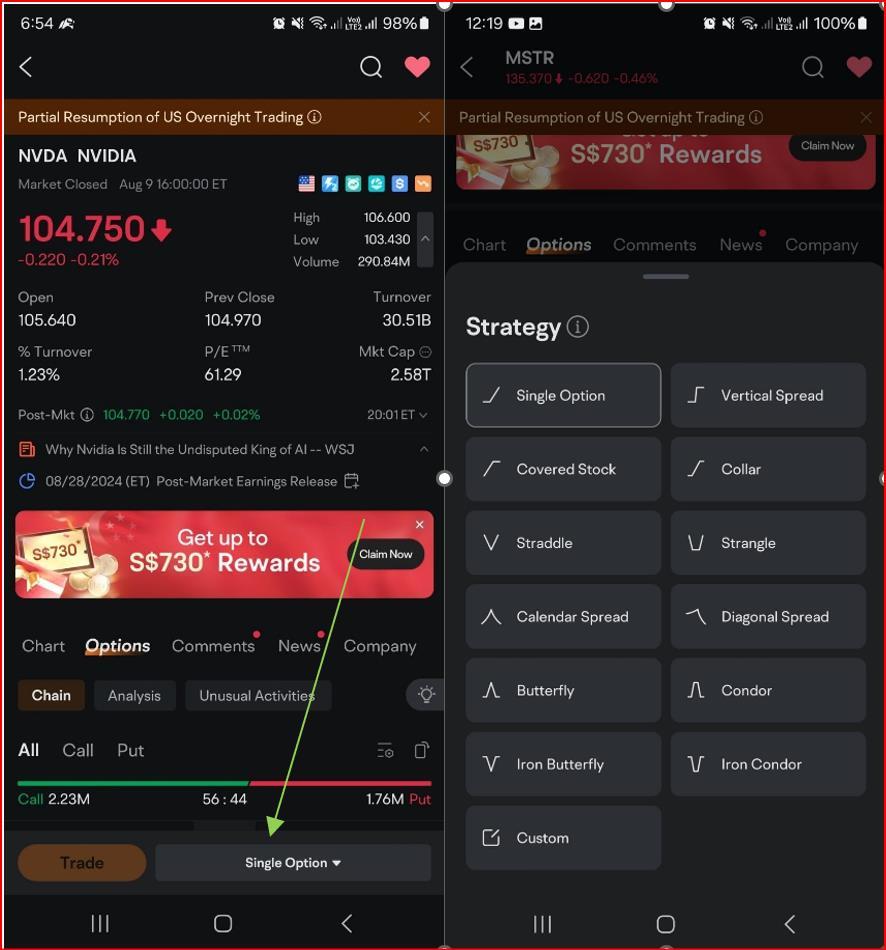moomooで説明される全オプション戦略(完全ガイド)- パート 1
こんにちは、皆さん、
これは、moomooが提供するすべての戦略をまとめるのに1週間かかりました
オプショントレーダーの場合、moomooを使用すると、多くの異なるストラテジーを選択して、オプションを個別に行わずに実行できます。特に、複数の脚を持つオプションの場合は便利です。
これを読んでいる方は、使用される戦略の一部を理解するためには、オプションの基本的な理解が必要です。
オプションをクリックすると、取引ボタンの横にMoomooが提供しているさまざまな戦略を表示するためのボタンがあります。
これは、moomooが提供するすべての戦略をまとめるのに1週間かかりました
オプショントレーダーの場合、moomooを使用すると、多くの異なるストラテジーを選択して、オプションを個別に行わずに実行できます。特に、複数の脚を持つオプションの場合は便利です。
これを読んでいる方は、使用される戦略の一部を理解するためには、オプションの基本的な理解が必要です。
オプションをクリックすると、取引ボタンの横にMoomooが提供しているさまざまな戦略を表示するためのボタンがあります。

現在、合計 12の戦略 から選ぶことができます:
1)シングルオプション
2) 垂直スプレッド
1)シングルオプション
3) カバードストック
4) コラー
5) ストラドル
6) ストラングル
7) カレンダースプレッド
8) 対角スプレッド4) コラー
5) ストラドル
6) ストラングル
7) カレンダースプレッド
9) バターフライ
10) コンドル
11) アイアンバタフライ
12) アイアンコンドル
10) コンドル
11) アイアンバタフライ
12) アイアンコンドル
それぞれの戦略について説明し、それらを使用すべき理由と使用方法について説明します
すべての例について、例としてNvidiaを使用します。
->を選択し、コールを売却して、プットを買うことができます。
いつものように、オプションには次のような選択肢しかありません2つの側面プレイできるものです買いまたは売り.
だから、すべての可能性を四分割すると、範囲が広がります4つの選択肢:

コールの性質は 強気 そしてプットの性質は 弱気
ですので、非常に明確です。オプションを買うことは、基礎の見通しに従ってプレミアムを支払うことを意味します
もしも コールを買う それはあなたが意味します 強気です
もしも プットを買う それはあなたがそれを意味することを意味します 弱気
オプションを売ることは基本的には基礎と見通しを反転させ、そのためにプレミアムを受け取ることです
もし コールを売る それはあなたがそれを意味することを意味します 弱気
もしもそれを売りするということは、あなたは強気であることを意味します プットを売る もしもそれを売りするということは、あなたは強気であることを意味します もしもそれを売りするということは、あなたは強気であることを意味します
真逆の見通し。単純
オプションを購入する際に表示されるさまざまな情報を見ていきます
コールまたはプットを購入する場合、最大損失は常にプレミアム支払額であり、理想的な状況(ITM)が発生しない場合の最大損失です。
この場合、アットザマネーでの購入の最大損失は390ドルであり、アットザマネープットの最大損失は305ドルです
最大利益部分について、なぜ1つが無制限(コール)を示し、別の1つが数値(プット)を示しているのか疑問に思う人もいるかもしれません。
これは、理論的にはコールを買う場合、価格は理論上無限になる可能性があるため(しかし実際には起こらない)、最大利益は「理論的には無制限」となります。
ですので、非常に明確です。オプションを買うことは、基礎の見通しに従ってプレミアムを支払うことを意味します
もしも コールを買う それはあなたが意味します 強気です
もしも プットを買う それはあなたがそれを意味することを意味します 弱気
オプションを売ることは基本的には基礎と見通しを反転させ、そのためにプレミアムを受け取ることです
もし コールを売る それはあなたがそれを意味することを意味します 弱気
もしもそれを売りするということは、あなたは強気であることを意味します プットを売る もしもそれを売りするということは、あなたは強気であることを意味します もしもそれを売りするということは、あなたは強気であることを意味します
真逆の見通し。単純
オプションを購入する際に表示されるさまざまな情報を見ていきます
コールまたはプットを購入する場合、最大損失は常にプレミアム支払額であり、理想的な状況(ITM)が発生しない場合の最大損失です。
この場合、アットザマネーでの購入の最大損失は390ドルであり、アットザマネープットの最大損失は305ドルです
最大利益部分について、なぜ1つが無制限(コール)を示し、別の1つが数値(プット)を示しているのか疑問に思う人もいるかもしれません。
これは、理論的にはコールを買う場合、価格は理論上無限になる可能性があるため(しかし実際には起こらない)、最大利益は「理論的には無制限」となります。
プットの場合、株価はゼロになることができる最低限です。したがって、プットを買う場合、最大利益は=(1ロット/100株)×(ブレークイベン価格)となります。
また、ブレークイベンは単純に行使価格から支払うプレミアムを引いたものです。
この戦略を実行するタイミングはいつですかトレーダーが株価がコールでは強く、プットでは下落すると考えた場合
利点100株の動きを制御するために少額の資本を使用することができます
デメリット時間的な減少はあなたに対して不利であり、成功の確率が低くなります
この戦略を実行するタイミングはいつですかトレーダーが株価がコールでは強く、プットでは下落すると考えた場合
利点100株の動きを制御するために少額の資本を使用することができます
デメリット時間的な減少はあなたに対して不利であり、成功の確率が低くなります

買いから売りに変更するには、前の画像で示されているようにボックスをクリックするだけで、それに応じて切り替わります。売り手は買い手が支払ったプレミアムを受け取ります。したがって、最大の利益は常に受け取ったプレミアムです。
この場合、売りのコールオプションの受け取ったプレミアムは$390であり、売りのプットオプションでは$305です(満期日は無視しています)
以下の最大損失は前の例と同じロジックです(両方ともペニーストックで行わない限り、起こりません)
今回、ブレークイーブンは単にストライク価格にプレミアムを加算または減算することです。なぜなら、プレミアムはブレークイーブンをサポートするクッションとして機能するからです。
売り手の側にいると成功する確率が高くなりますが、報酬は制限されます
カバードコールを売る場合は、株式の100株が必要です。そうでない場合は、売り出しオプション(やめましょう)と見なされます。キャッシュセキュアリングプットを売る場合は、100株を購入するための担保(資金)が必要です。そうでない場合は、売り出しオプション(これもやめましょう)と見なされます。
この戦略を実行するタイミングはいつですか収入増加または特定の価格で株を購入するか(プットを売る)、または特定の価格で株を売却することを試みるための戦略
利点:タイムディケイが味方しており、成功の可能性が高くなります
欠点:報酬が限定されています。株価が急落したり上昇した場合、損害を被ることになります

2) -> バーティカルスプレッド
バーティカルスプレッドとは基本的に買うそしてコールまたはプットの売りオプションを同時に2本の足で構成されています。つまり、置く必要のある取引が2つあります。
異なる行使価格の2つのオプションを同じ満期日で取引しているためです。行使価格はオプションチェーンで垂直にリストされています。つまり、基本的には垂直にスプレッドを作成しています。
Moomooを使用すると、スプレッドの幅を選択できます。幅とはコールとプットの価格のスプレッドを指します。簡単のため、すべての例では幅を10に設定します。
合計4つのタイプ垂直スプレッド戦略は次のようになる。
1) ブルコールスプレッド(強気)
2) ブルプットスプレッド(強気)
3) ベアコールスプレッド(弱気)
4) ベアプットスプレッド(弱気)
ブルコールスプレッド(コールデビットスプレッド)同じ満期日で、より低い権利行使価格でコールオプションを買い、より高い権利行使価格でコールオプションを売ること。
垂直スプレッドをクリックして、幅を10に設定し、Callを選択して購入します。
ここで選択した幅が$10離れていることがわかります。
下の詳細も確認できます:
104を購入
114を売却
スプレッドの場合、最大利益は常に(幅の価格)×(100株/1ロット)-コールオプションのプレミアム支払いを控除した額です。
つまり、10(幅)×100株-((3.31 + 3.42)/2)×100株=1000-336.50 = $663.50
= $663.50
以前に計算した最大損失は、支払ったプレミアム=[(3.31 + 3.42)/ 2] X 100株 = $336.50
バッテリー電気自動車(BEV)用のBear Call Spread(コールクレジットスプレッド)、それはちょうど逆です。(買いの代わりに売りをクリックします)
今回は、ストライク価格が低いコールを売却し、ストライク価格が高いコールを購入します(文字通りBull Callの逆です)
今回は、ストライク価格が低いコールを売却し、ストライク価格が高いコールを購入します(文字通りBull Callの逆です)
(注意しておくべきことは、それらがまだ「Call」カテゴリーに含まれていることです)
今度は買い手側ではなく、売り手側になっているため、最大利益と最大損失はそれに応じて交換されます。
売り手側では、最大利益は常に受け取ったプレミアムです。
今度は買い手側ではなく、売り手側になっているため、最大利益と最大損失はそれに応じて交換されます。
売り手側では、最大利益は常に受け取ったプレミアムです。

3番目のもの,ベアプットスプレッド (プットデビットスプレッド)。これはプットカテゴリーの下です
ベアプットスプレッドでは、より高いストライク価格でプットを買い、同じ満期日でより低いストライク価格でプットを売ります。
前述の幅と同じ10
[(6.55 + 6.80) / 2] × 100株 = 667.50ドルが最大の損失です。
最大の利益は104のプットを売ることで得られるプレミアムです。
ベアプットスプレッドでは、より高いストライク価格でプットを買い、同じ満期日でより低いストライク価格でプットを売ります。
前述の幅と同じ10
[(6.55 + 6.80) / 2] × 100株 = 667.50ドルが最大の損失です。
最大の利益は104のプットを売ることで得られるプレミアムです。

最後の垂直スプレッド用のものですブルプットスプレッド。 (プットクレジットスプレッド)
これは前のベアプットスプレッドとはまったく逆です。買うの代わりに売るをクリックします。
ブルプットスプレッドでは、より高い行使価格でプットを売り、同じ満期日でより低い行使価格でプットを買います。
また、この状況では、買いから売りへの役割の変更が発生するため、同様です。
最大利益と損失はそれに応じてスワップされます。
これは前のベアプットスプレッドとはまったく逆です。買うの代わりに売るをクリックします。
ブルプットスプレッドでは、より高い行使価格でプットを売り、同じ満期日でより低い行使価格でプットを買います。
また、この状況では、買いから売りへの役割の変更が発生するため、同様です。
最大利益と損失はそれに応じてスワップされます。

全体的に、垂直スプレッド戦略は、選んだ幅(スプレッド)内で株価が動く場合に利益を上げることができるリスクと報酬が限られた戦略です。
望ましい結果は、もう片方の足の割り当てをトリガしないまま、価格がITMまたはOTMになることです。
この戦略を実行するタイミングはいつですか:株式に対して方向性のある見通しがあり、それがこの範囲内で動くと考える場合
アドバンテージ:プレミアムの受け取り額または支払額で最大損失が制限されるため、損失/リスクの露出が限定されます。市場の見通しに合わせて戦略を実行するために必要な資金はごくわずかであり、強気または弱気の視点に適したものです。割り当てがないことを考慮すると、規模を拡大しようとしている小口から中口のアカウントにとって良いです。
デメリット :利益のポテンシャルが限定されます。2つのポジションを持つため、取引に対してより多くの手数料が支払われ、初心者にとっては実行またはクローズするのがより複雑ですm.
次に取り組む戦略は次のものですカバー株これはよりシンプルで直接的な戦略の1つです。
このカバー株にはカバードがあります コール または プット
カバードコールを購入する場合、基礎となる株式を100株/1ロット購入し、コールを売ります。この取引を実行する際に、すでに100株の株式を所有しているため、コールはカバーされます。
この取引での最大利益は受け取ったプレミアムであり、最大損失は株価がゼロになる場合にプレミアムを考慮した場合です。
1ロットあたりの100株×104ドル-313.50ドル=10,086.50ドル
望ましい結果は、もう片方の足の割り当てをトリガしないまま、価格がITMまたはOTMになることです。
この戦略を実行するタイミングはいつですか:株式に対して方向性のある見通しがあり、それがこの範囲内で動くと考える場合
アドバンテージ:プレミアムの受け取り額または支払額で最大損失が制限されるため、損失/リスクの露出が限定されます。市場の見通しに合わせて戦略を実行するために必要な資金はごくわずかであり、強気または弱気の視点に適したものです。割り当てがないことを考慮すると、規模を拡大しようとしている小口から中口のアカウントにとって良いです。
デメリット :利益のポテンシャルが限定されます。2つのポジションを持つため、取引に対してより多くの手数料が支払われ、初心者にとっては実行またはクローズするのがより複雑ですm.
次に取り組む戦略は次のものですカバー株これはよりシンプルで直接的な戦略の1つです。
このカバー株にはカバードがあります コール または プット
カバードコールを購入する場合、基礎となる株式を100株/1ロット購入し、コールを売ります。この取引を実行する際に、すでに100株の株式を所有しているため、コールはカバーされます。
この取引での最大利益は受け取ったプレミアムであり、最大損失は株価がゼロになる場合にプレミアムを考慮した場合です。
1ロットあたりの100株×104ドル-313.50ドル=10,086.50ドル

売り側の場合、前回の取引と逆のことをしています
100株/1ロットを売却し、コールオプションを購入することです
コールオプションを買うということは、自然と最大損失は支払ったプレミアムになります
100株/1ロットを売却し、コールオプションを購入することです
コールオプションを買うということは、自然と最大損失は支払ったプレミアムになります

プット側の場合、買いをクリックすると保護的なプット戦略になり、100株/1ロットを購入し、保護のためにプットを購入します
最大損失もオプションのために支払ったプレミアムで、理論上は利益は無限大です
最大損失もオプションのために支払ったプレミアムで、理論上は利益は無限大です

売り側の場合、プットオプションを売却し、100株/1ロットを新規売りします
得られる最大利益は受け取ったプレミアムで、最大損失は理論上は無制限です
得られる最大利益は受け取ったプレミアムで、最大損失は理論上は無制限です

この戦略を実行するタイミングはいつですか:
1) カバードコール-収入を生み出し、希望の価格で株式を売却するため2) プロテクティブコール/シンセティックロングプット-価格が予想外に上昇した場合に潜在的な損失を制限するため
3) プロテクティブプット-既に所有している株式を保護し、クッションとして機能するため
4) カバード・プット – 収入を生むために使用され、希望価格で株式を購入するために利用されます
次に私たちが見ていく戦略はカラー(プロテクティブプット+カバードコール)
カラー戦略は、2つのレッグ(3つのパーツ)で構成され、コールオプションとプットオプションの価格幅を選択し、防御的な戦略です。
カラー戦略では、コールまたはプットを選択することはできませんが、買いまたは売りを選択することはできます。
これは、カラー戦略にコールとプットの両方が存在するため、選択する必要がないためです。
カラーオプションでは、以前に使用した価格幅を同じく使用します。すなわち10です。
もしも買いをクリックすると、100株の株式/1Lot の株を購入し、プットオプションを購入し、コールオプションを売却することが含まれていることがわかります(ロングカラー)。
最大利益と損失の両方が一定の金額で上限が設けられていることがわかります。
幅が関わる場合、通常最大の利益は 幅 x 100 株です。
この場合は 10 x 100 = $1000 です。
プットオプションを買うための支払いプレミアムは $328 です。
したがって、支払いプレミアムを差し引いた場合、最大の利益は $1000-$328 = $672 です。

そして、セルをクリックすると、前のものの逆バージョンになります (ショートカラー)。
買い、買い、売り の代わりに、売り、売り、買い になります。
買い、買い、売り の代わりに、売り、売り、買い になります。

カラー戦略は、ポートフォリオを育てたい初心者や攻撃的ではない守備的な戦略の一部としての小さな口座を持つ人にとって良いです。
この戦略を実行するタイミングはいつですか?株価が上昇し、潜在的な下落リスクに備えたい場合に利用できます。これは、株式の短期的な方向性が不確かな決算説明会などにも適用できます。ヘッジとしてもよく使用されます。
利点:リスクを最小限に抑えるために最大損失をプレミアムで受け取るか支払うことで設定します。売却したプレミアムはオプションの購入コストを相殺して、純中立にできる。
デメリット :利益の可能性が限定されていることも同様。2つの脚があるため、取引に対してより多くの手数料が支払われ、初心者にとってはポジションを実行または解消するのがより複雑です。
次は ストラドル.
ストラドルは非常にシンプルで直感的な戦略です。
ストラドル自体は中立的な戦略です。
ストラドルは2本足の戦略です。
ストラドルには2つの種類があります: 新規買ストラドル と あなたにおすすめ: オプション取引の方法
ロングストラドルは、価格の大きなスイングを予期しているが、どちらの方向に行くかはわからない場合に使用されます。同じストライク価格で同じ満期日にプットオプションとコールオプションを買うことを含みます。
Buyをクリックすると、Long Straddleになり、適切な行使価格を選択できます。
最大損失は、オプション両方を購入するために支払ったプレミアムです。最大利益は理論的に無限大です。株価は無限に上がる可能性があります。
約定済み価格から支払ったプレミアムを差し引いた価格がブレークイベン価格です。利益を得るためには、ブレークイベン価格を上回るか下回る必要があります。
この戦略を実行するタイミングはいつですか?株価が上昇し、潜在的な下落リスクに備えたい場合に利用できます。これは、株式の短期的な方向性が不確かな決算説明会などにも適用できます。ヘッジとしてもよく使用されます。
利点:リスクを最小限に抑えるために最大損失をプレミアムで受け取るか支払うことで設定します。売却したプレミアムはオプションの購入コストを相殺して、純中立にできる。
デメリット :利益の可能性が限定されていることも同様。2つの脚があるため、取引に対してより多くの手数料が支払われ、初心者にとってはポジションを実行または解消するのがより複雑です。
次は ストラドル.
ストラドルは非常にシンプルで直感的な戦略です。
ストラドル自体は中立的な戦略です。
ストラドルは2本足の戦略です。
ストラドルには2つの種類があります: 新規買ストラドル と あなたにおすすめ: オプション取引の方法
ロングストラドルは、価格の大きなスイングを予期しているが、どちらの方向に行くかはわからない場合に使用されます。同じストライク価格で同じ満期日にプットオプションとコールオプションを買うことを含みます。
Buyをクリックすると、Long Straddleになり、適切な行使価格を選択できます。
最大損失は、オプション両方を購入するために支払ったプレミアムです。最大利益は理論的に無限大です。株価は無限に上がる可能性があります。
約定済み価格から支払ったプレミアムを差し引いた価格がブレークイベン価格です。利益を得るためには、ブレークイベン価格を上回るか下回る必要があります。

Sellをクリックすると、Short Straddleを行います。株式の動きがないか、わずかな動きを予想する場合にのみ、Short Straddleを行ってください。
ショートストラドルは、ロングストラドルの正反対です。コールオプションとプットオプションを売ります。
最大利益は両方のオプションの売却から受け取ったプレミアムです。最大損失は理論的に無限大です。株価は無限に上がる可能性があります(理論的には)。
ショートストラドルは、ロングストラドルの正反対です。コールオプションとプットオプションを売ります。
最大利益は両方のオプションの売却から受け取ったプレミアムです。最大損失は理論的に無限大です。株価は無限に上がる可能性があります(理論的には)。

ロングストラドル:
この戦略を実行するタイミングはいつですか大きな価格変動やボラティリティを期待する場合には、ロングストラドルを実行すべきです。これは、決算説明会の時に有益で、価格は不明ですが、変動がどちらの方向にも大きいことは確実です。
利点正しい場合、大きな動きから利益を得ることができ、実行が簡単です。
欠点:2つのオプションを購入するため、費用が高くなります。このシナリオでは時間の経過があなたに逆らいます。利益を得るためには、平均純利益価格を超える大きな価格変動が必要です。
ショートストラドル
この戦略を実行するタイミング価格やボラティリティの変動がほとんどないと予想される場合、または価格が安定し、狭い範囲内で静かな市場で実行する場合に、ロングストラドルを実行する必要があります。ただし、上級者にのみ推奨します。
利点正しい場合と時間の経過が有利であるなら、オプションの両側から収入を得ることができます
欠点:大きな値動きがある場合、大きな損失になる高リスクな戦略です
次の戦略はストラドルと非常に似ていますが、柔軟性が追加されています
それがストラングルです
これも2つの足を持つ中立戦略です
ストラングルには2つのタイプの戦略があります新規買ストラングルandショート・ストラングル戦略は、下限点と上限点の間で原資産の株価が狭い範囲で取引される場合に利益を上げることができます。
ロングストレングル(長期選択)とロングストラドル(長期ストラドル)の違いは、ロングストレングルではストライク価格の幅を選ぶことができることです。
いつものように、説明のために幅10を使用します。
ロングストレングルについて見てみましょう。
ロングストレングルを行うには、買うをクリックする必要があります。そしてそこには2つのオプションの買い注文が表示されます:
プットとコールです。通常、オプションの買い注文では、利益は理論的に無限大であり、損失は両方のオプションのプレミアムの支払い額となります。
利点正しい場合、大きな動きから利益を得ることができ、実行が簡単です。
欠点:2つのオプションを購入するため、費用が高くなります。このシナリオでは時間の経過があなたに逆らいます。利益を得るためには、平均純利益価格を超える大きな価格変動が必要です。
ショートストラドル
この戦略を実行するタイミング価格やボラティリティの変動がほとんどないと予想される場合、または価格が安定し、狭い範囲内で静かな市場で実行する場合に、ロングストラドルを実行する必要があります。ただし、上級者にのみ推奨します。
利点正しい場合と時間の経過が有利であるなら、オプションの両側から収入を得ることができます
欠点:大きな値動きがある場合、大きな損失になる高リスクな戦略です
次の戦略はストラドルと非常に似ていますが、柔軟性が追加されています
それがストラングルです
ストラングルには2つのタイプの戦略があります新規買ストラングルandショート・ストラングル戦略は、下限点と上限点の間で原資産の株価が狭い範囲で取引される場合に利益を上げることができます。
ロングストレングル(長期選択)とロングストラドル(長期ストラドル)の違いは、ロングストレングルではストライク価格の幅を選ぶことができることです。
いつものように、説明のために幅10を使用します。
ロングストレングルについて見てみましょう。
ロングストレングルを行うには、買うをクリックする必要があります。そしてそこには2つのオプションの買い注文が表示されます:
プットとコールです。通常、オプションの買い注文では、利益は理論的に無限大であり、損失は両方のオプションのプレミアムの支払い額となります。

新規売ストラングルでは、新規売をクリックする必要があります。それにより、希望する幅でプットとコールの両方が「売り」として表示されます。
オプションを売る場合、最大利益は常に収集したプレミアムに制限され、損失は理論的には無限です。
オプションを売る場合、最大利益は常に収集したプレミアムに制限され、損失は理論的には無限です。

ロングストラングル:
この戦略を実行するタイミングはいつですか: 値段やボラティリティが大きく変動することを予想する場合には、新規買ストラドルを実行すべきです。株価が未知であるが変動が大きいと確信できるとき、これは決算説明会の時に良いです。
利点: 正しければ大きな動きから利益を上げることができ、実行が簡単でストラドルよりもコストが低くなります。
欠点:あなたのブレークイーブン価格を超えて利益を得るためには、価格の大きな振れ幅が必要です。時間の経過があなたに有利ではありません。
ショート・ストラングル:
この戦略を実行するタイミングはいつですか価格の振れ幅やボラティリティがほとんどないと予想される場合に、ロング・ストラドルを実行するべきです。市場が安定しており、狭い範囲内で穏やかな場合に実行できます。
利点オプションの両側から収入を得ることができ、価格の振れ幅が小さく時間の経過があなたに有利な場合には、ショート・ストラドルに比べてマージンが少なくて済みます(選択した幅に依存します)。
デメリット:プレミアムを受け取ることで収益の可能性は限られており、価格の急激な変動があると大きな損失につながることがあります。
利点: 正しければ大きな動きから利益を上げることができ、実行が簡単でストラドルよりもコストが低くなります。
欠点:あなたのブレークイーブン価格を超えて利益を得るためには、価格の大きな振れ幅が必要です。時間の経過があなたに有利ではありません。
ショート・ストラングル:
この戦略を実行するタイミングはいつですか価格の振れ幅やボラティリティがほとんどないと予想される場合に、ロング・ストラドルを実行するべきです。市場が安定しており、狭い範囲内で穏やかな場合に実行できます。
利点オプションの両側から収入を得ることができ、価格の振れ幅が小さく時間の経過があなたに有利な場合には、ショート・ストラドルに比べてマージンが少なくて済みます(選択した幅に依存します)。
デメリット:プレミアムを受け取ることで収益の可能性は限られており、価格の急激な変動があると大きな損失につながることがあります。
次に見ていくのはカレンダースプレッドです。
この概念はカレンダーとスプレッドという2つの単語から簡単に解説できます。
スプレッドは同じストライキ価格でオプションの売買を意味し、カレンダーは異なる満期日/カレンダー期間を意味します。
カレンダースプレッドは2本のレッグで行われます - コールの売り/コールの買いまたはプットの売り/プットの買い
次に見ていくのはコールカレンダースプレッド、またはロングカレンダースプレッドです。
ここでは、長期のコールオプションを購入し、同じストライキ価格の短期コールオプションを売却します。
カレンダースプレッドでは、満期日を自由に選択できます。+1から+19まで
この例では、21日離れた+3 Expを使用します
最大利益は、バックマンスコールのプレミアムからコールを購入するコストを差し引いたものに制限されます - ポジションを確立するために支払うネットデビット
最大損失は、取引を確立するために支払ったプレミアムだけです
この概念はカレンダーとスプレッドという2つの単語から簡単に解説できます。
スプレッドは同じストライキ価格でオプションの売買を意味し、カレンダーは異なる満期日/カレンダー期間を意味します。
カレンダースプレッドは2本のレッグで行われます - コールの売り/コールの買いまたはプットの売り/プットの買い
次に見ていくのはコールカレンダースプレッド、またはロングカレンダースプレッドです。
ここでは、長期のコールオプションを購入し、同じストライキ価格の短期コールオプションを売却します。
カレンダースプレッドでは、満期日を自由に選択できます。+1から+19まで
この例では、21日離れた+3 Expを使用します
最大利益は、バックマンスコールのプレミアムからコールを購入するコストを差し引いたものに制限されます - ポジションを確立するために支払うネットデビット
最大損失は、取引を確立するために支払ったプレミアムだけです

売るをクリックすると、最大利益と損失が入れ替わります。なぜなら、長期コールオプションを売却し、短期コールオプションを同じ行使価格で買うカレンダーコールスプレッドを現在ショートしているからです

プットカレンダーオプションの場合、買いと売りがあります
買う場合、それはプットのロングカレンダースプレッドとして知られます。ここでは、より近い有効期限のプットを売却し、同じ行使価格で長期の有効期限プットを購入します
最大利益と損失はほとんど同じですが、今度はコールではなくプットを使っています
買う場合、それはプットのロングカレンダースプレッドとして知られます。ここでは、より近い有効期限のプットを売却し、同じ行使価格で長期の有効期限プットを購入します
最大利益と損失はほとんど同じですが、今度はコールではなくプットを使っています

プットカレンダースプレッドの場合、これは前述のものとは逆であり、最大損失と利益も入れ替わります

新規買い範囲を持つコールオプション:
この戦略を実行するタイミングはいつですか: 特定の時間枠内で株価の動きが最小限であると予想される場合(低ボラティリティ)
アドバンテージ:最大損失はプレミアムでキャップされるため、損失/リスクが限定的です。 売却から受け取ったプレミアムは、オプションの買い付けコストを相殺し、純中立にすることができます。
ディスアドバンテージ:利益/利益の潜在性が限られています。2本脚があるため、取引によりより多くの手数料が支払われ、初心者がポジションを実行または解消する場合に複雑です。
コールオプションを使用したショートカレンダースプレッド:
この戦略を実行するタイミング近い期限のオプションの満期前に、任意の方向に対してストライク価格から価格が急激に動くことを予想している場合
利点価格が大幅に動くと、長期オプションの価値がより速く減少し、有利なポジションになります。純クレジットを受け取りました。
デメリット:価格が不利な方向に動いた場合、損失がプレミアムを上回る可能性があります
プットオプションを使用したロングカレンダースプレッド:
この戦略を実行するタイミング:ネガティブな見通しで、近い将来のオプションが満期になるまでに株価がストライクプライスの近くに留まるか下落することを予想しています(低ボラティリティ)
メリット:プレミアムでの最大損失がキャップされるため、損失/リスクへの露出が限られます。短期オプションによる時間的な減衰の速い利益
デメリット:利益は上限があり、ストライクプライスから価格が大幅に変動すると損失を被る可能性があります。
プットオプションを使用した短期カレンダースプレッド:
この戦略を実行するタイミングはいつですか株価が行使価格から遠く移動する強い大規模な動きが期限切れの近いオプションの前に予想される場合に実行します。
利点ネットクレジットを受け取り、価格が十分に強く移動した場合、より長い期間のオプションが早く価値を失い、利益を得ることができます。
デメリット:この戦略は慎重な管理が必要であり、長期カレンダースプレッドよりもリスクが高いです。価格が逆に動いた場合、損失は受け取ったプレミアムを上回る可能性があります。
この戦略を実行するタイミングはいつですか: 特定の時間枠内で株価の動きが最小限であると予想される場合(低ボラティリティ)
アドバンテージ:最大損失はプレミアムでキャップされるため、損失/リスクが限定的です。 売却から受け取ったプレミアムは、オプションの買い付けコストを相殺し、純中立にすることができます。
ディスアドバンテージ:利益/利益の潜在性が限られています。2本脚があるため、取引によりより多くの手数料が支払われ、初心者がポジションを実行または解消する場合に複雑です。
コールオプションを使用したショートカレンダースプレッド:
この戦略を実行するタイミング近い期限のオプションの満期前に、任意の方向に対してストライク価格から価格が急激に動くことを予想している場合
利点価格が大幅に動くと、長期オプションの価値がより速く減少し、有利なポジションになります。純クレジットを受け取りました。
デメリット:価格が不利な方向に動いた場合、損失がプレミアムを上回る可能性があります
プットオプションを使用したロングカレンダースプレッド:
この戦略を実行するタイミング:ネガティブな見通しで、近い将来のオプションが満期になるまでに株価がストライクプライスの近くに留まるか下落することを予想しています(低ボラティリティ)
メリット:プレミアムでの最大損失がキャップされるため、損失/リスクへの露出が限られます。短期オプションによる時間的な減衰の速い利益
デメリット:利益は上限があり、ストライクプライスから価格が大幅に変動すると損失を被る可能性があります。
プットオプションを使用した短期カレンダースプレッド:
この戦略を実行するタイミングはいつですか株価が行使価格から遠く移動する強い大規模な動きが期限切れの近いオプションの前に予想される場合に実行します。
利点ネットクレジットを受け取り、価格が十分に強く移動した場合、より長い期間のオプションが早く価値を失い、利益を得ることができます。
デメリット:この戦略は慎重な管理が必要であり、長期カレンダースプレッドよりもリスクが高いです。価格が逆に動いた場合、損失は受け取ったプレミアムを上回る可能性があります。
次の戦略は、新規買となります。 対角線スプレッド。それは別名修正カレンダースプレッドとして知られており、異なる行使価格を使用します。
まず、対角線コールスプレッドを見ていきます。
これは基礎となる株について穏健に強気である場合に通常使用されます
この戦略の構造は、より短期の有効期限を持つ行使価格が高いコールオプションを売却し、より長期の有効期限を持つ行使価格が低いコールオプションを購入することです。
対角スプレッドでは、有効期限の幅と行使価格の幅を選択する必要があります。
有効期限の幅とは、スプレッドの有効期限日を単に指します。
+1の経験値は7日間です
+2の経験値は14日間です
+3の経験値は21日間です
それ以降も同様です
ストライク幅は、ストライク価格の間の距離を指します。(例:107 - 102)
ここで使用されている例は、+1のExpで、ストライク幅は5です
これは基礎となる株について穏健に強気である場合に通常使用されます
この戦略の構造は、より短期の有効期限を持つ行使価格が高いコールオプションを売却し、より長期の有効期限を持つ行使価格が低いコールオプションを購入することです。
対角スプレッドでは、有効期限の幅と行使価格の幅を選択する必要があります。
有効期限の幅とは、スプレッドの有効期限日を単に指します。
+1の経験値は7日間です
+2の経験値は14日間です
+3の経験値は21日間です
それ以降も同様です
ストライク幅は、ストライク価格の間の距離を指します。(例:107 - 102)
ここで使用されている例は、+1のExpで、ストライク幅は5です

対角状のコールスプレッドの場合、最大利益は、株価が短期コールオプションのストライク価格に近い場合に得られるプレミアムです。この場合、最大損失は、長期オプションの購入に支払ったプレミアムです。この場合、$ 355.50です

ショート対角状のコールスプレッド戦略では、ほとんど逆です
これは、根底の株に対して弱気な相場観を持っている場合に通常使用されます。
この戦略の構造は、より近い満期日と高い行使価格を持つより長期のコールオプションを売り、より後の満期日と低い行使価格でより短期のコールオプションを買うことです。
私たちは同じパラメータを使用します。
ここで使用されている例は、+1の経験値で、ストライク幅は5です
これは、根底の株に対して弱気な相場観を持っている場合に通常使用されます。
この戦略の構造は、より近い満期日と高い行使価格を持つより長期のコールオプションを売り、より後の満期日と低い行使価格でより短期のコールオプションを買うことです。
私たちは同じパラメータを使用します。
ここで使用されている例は、+1の経験値で、ストライク幅は5です

前のDiagonal Call Spreadとは異なり、最大利益と最大損失が入れ替わっています。
最大の利益は、より長期の低い行使価格のオプションを売ることから得られ、価格がより短期のコールオプションの行使価格(<= $102)以下になる場合、後者のコールオプションが満期になったとき。
短いコールを売却した場合、株価が短いコールの行使価格を大幅に上回ると最大損失が発生しますが、長期コールもその価値が増加するために損失が発生します。(>$107)
斜めのコールスプレッド:
この戦略を実行するタイミングはいつですか:株価の上昇を期待していますが、短いコールの行使価格を大幅に上回ることはないと予想しています。価格は範囲内で変動することを期待しています
利点:オプションを売ることでデビットを相殺するためのクレジットを得ることができます。ロングコールはその価値を持っている間に時間経過による利益を得ることができます
これは小口取引に適した低コスト戦略でもあります。
デメリット:この戦略は慎重な管理と監視が必要です
それには利益の上昇が限られています。
ショート・ダイアゴナル・コール・スプレッド:
この戦略を実行するタイミング短期コールオプションの行使価格を下回るか、同等の水準に留まる株価が期待される場合に実行します。
メリットこの戦略は、基礎資産が同じか下落する場合に恩恵を受けます。両方のオプションが無効になったり、ほとんど無価値になったりするため、最大の信用をもたらします。リスクは限定されており、小口座向けの低コスト戦略です。
ディサドバンテージ:この戦略は注意深い管理とモニタリングが必要です
同様に上限の利益ポテンシャルに制限があります。
最大の利益は、より長期の低い行使価格のオプションを売ることから得られ、価格がより短期のコールオプションの行使価格(<= $102)以下になる場合、後者のコールオプションが満期になったとき。
短いコールを売却した場合、株価が短いコールの行使価格を大幅に上回ると最大損失が発生しますが、長期コールもその価値が増加するために損失が発生します。(>$107)
斜めのコールスプレッド:
この戦略を実行するタイミングはいつですか:株価の上昇を期待していますが、短いコールの行使価格を大幅に上回ることはないと予想しています。価格は範囲内で変動することを期待しています
利点:オプションを売ることでデビットを相殺するためのクレジットを得ることができます。ロングコールはその価値を持っている間に時間経過による利益を得ることができます
これは小口取引に適した低コスト戦略でもあります。
デメリット:この戦略は慎重な管理と監視が必要です
それには利益の上昇が限られています。
ショート・ダイアゴナル・コール・スプレッド:
この戦略を実行するタイミング短期コールオプションの行使価格を下回るか、同等の水準に留まる株価が期待される場合に実行します。
メリットこの戦略は、基礎資産が同じか下落する場合に恩恵を受けます。両方のオプションが無効になったり、ほとんど無価値になったりするため、最大の信用をもたらします。リスクは限定されており、小口座向けの低コスト戦略です。
ディサドバンテージ:この戦略は注意深い管理とモニタリングが必要です
同様に上限の利益ポテンシャルに制限があります。
次に、ダイアゴナルプットスプレッドとショートダイアゴナルプットスプレッドについて説明します。
ダイアゴナルプットスプレッドは、長期のオプションを購入し、異なる行使価格を持つ短期プットオプションを売ることを含みます。
ダイアゴナルプットスプレッドは、長期のオプションを購入し、異なる行使価格を持つ短期プットオプションを売ることを含みます。

最大の利益は、短期プットの行使期日に基礎資産が近くまたはわずかに行使価格を上回った場合に発生します。短期プットは無価値になり、長期プットは一部の価値を維持します。 ($324)
最大の損失は、株価が両方の行使価格を大幅に上回る場合です。この場合、両方のプットオプションは無価値になり、最大の損失が生じます。ネット支払額($355)
最大の損失は、株価が両方の行使価格を大幅に上回る場合です。この場合、両方のプットオプションは無価値になり、最大の損失が生じます。ネット支払額($355)
逆に、短い期間のプットオプションを売り、より長い期間のプットオプションを買うことでショート対角プットスプレッドを作成します。

最大利益は、株価がより高い、売った長期プットの行使価格のままの時に発生します。これにより、両方のオプションが無価値で満期となります。
一方、最大損失は、株価が長期プットの行使価格を大幅に下回った場合に発生します。この場合、長期プットの価値が増加し、一方で短期プットは満期となります。
一方、最大損失は、株価が長期プットの行使価格を大幅に下回った場合に発生します。この場合、長期プットの価値が増加し、一方で短期プットは満期となります。
対角プットスプレッド:
この戦略を実行するタイミングはいつですか株価がわずかに下落するか、安定すると予想していますが、大きな下降はないと思われます。また、一定の範囲内で取引されると予想しています。
利点初期純借入額までのリスクが上限になっており、株の空売りや単独でプットを買うよりも安全です。
欠点:新規売と新規買のストライク価格の関係に基づいて、利益の最大値は制限されます。また、新規売の満期を管理し、必要に応じて新規買を調整することは難しい場合があります。
について->ショートダイアゴナルプットスプレッド:
この戦略を実行するタイミングはいつですか株価が安定するか、またはわずかに上昇することを予想しています。市場が一定の価格範囲内にとどまる場合が最適です
利点短期プットオプションの購入によりリスクが制限されるため、裸のプットオプションの売却に比べてリスクを抑えることができます。また、長期プットオプションの売却によりプレミアムを受け取ることができ、株価が範囲内にあるか上昇する場合には収入を得ることができます
デメリット:最大利益の上限は最初の純クレジットを受け取った時点であり、株価が大幅に上昇する場合には追加の利益に参加することができません。また、ポジションの管理、特に短期プットオプションの満期に近い場合は複雑で調整が必要な場合があります
この戦略を実行するタイミングはいつですか株価が安定するか、またはわずかに上昇することを予想しています。市場が一定の価格範囲内にとどまる場合が最適です
利点短期プットオプションの購入によりリスクが制限されるため、裸のプットオプションの売却に比べてリスクを抑えることができます。また、長期プットオプションの売却によりプレミアムを受け取ることができ、株価が範囲内にあるか上昇する場合には収入を得ることができます
デメリット:最大利益の上限は最初の純クレジットを受け取った時点であり、株価が大幅に上昇する場合には追加の利益に参加することができません。また、ポジションの管理、特に短期プットオプションの満期に近い場合は複雑で調整が必要な場合があります
次に進む
バタフライオプションについて話しましょう。具体的には、バタフライコールスプレッドとショートバタフライコールスプレッドについてです。
バタフライオプションについて話しましょう。具体的には、バタフライコールスプレッドとショートバタフライコールスプレッドについてです。
バタフライオプションは、4つのオプションを使って3つの脚をセットアップすることを含みます。
バタフライコールスプレッドでは、より低いストライキでコールオプションを1本買い、中間のストライキでコールオプションを2本売り、より高いストライキでコールオプションを1本買います。全てのオプションは同じ満期日です。これは中立な戦略および低ボラティリティまたは特定の価格目標から利益を得ます。
これはあなたのようなビジネスにとっての甘いスポットです中立戦略低ボラティリティや特定の価格目標から利益を得ます。
バタフライコールスプレッドでは、より低いストライキでコールオプションを1本買い、中間のストライキでコールオプションを2本売り、より高いストライキでコールオプションを1本買います。全てのオプションは同じ満期日です。これは中立な戦略および低ボラティリティまたは特定の価格目標から利益を得ます。
これはあなたのようなビジネスにとっての甘いスポットです中立戦略低ボラティリティや特定の価格目標から利益を得ます。
例を示すために、ストライク幅5を選択します。


最大の利益は、基礎となる資産の価格が中間のストライク価格で満期時に発生します。 ($107ストライク価格)
高いストライク価格と低いストライク価格のコールは無効になり、2つのショートコールは最も利益を生み出します。なぜなら、彼らは金銭的にもっとも近い場所であるからです。
高いストライク価格と低いストライク価格のコールは無効になり、2つのショートコールは最も利益を生み出します。なぜなら、彼らは金銭的にもっとも近い場所であるからです。
最大の損失は、基礎となる株価がまたは下方のストライク価格以下の場合に発生します。または騰落予想は、高ストライク上または等価以上である満期時には、両方のロングオプションが無価値になり、損失は取引の初期コストです
ショートバタフライコールスプレッドでは、標準バタフライスプレッドの逆のポジションを取ります。下限ストライクでコール1つを売り、中間ストライクでコール2つを買い、高ストライクでコール1つを売ります。これも中立から変動する戦略です中立から変動する戦略です株価がどちらの方向にも大きく動くことを期待する戦略です
ショートバタフライコールスプレッドでは、標準バタフライスプレッドの逆のポジションを取ります。下限ストライクでコール1つを売り、中間ストライクでコール2つを買い、高ストライクでコール1つを売ります。これも中立から変動する戦略です中立から変動する戦略です株価がどちらの方向にも大きく動くことを期待する戦略です

株価が上記最高行使価格を超えた場合、最大利益が発生します下限ストライクよりも株価が低い場合ですまたはabove the higher strikeat expiration. In this case, all options expire worthless, and you keep the initial credit received
While the maximum loss occurs if the stock price is真ん中の行使価格に正確にat expiration. In this scenario, the two long calls you purchased will incur maximum losses, while the short calls will provide no offset.
Butterfly Call Spread:
この戦略を実行するタイミングはいつですか株価が狭い範囲で取引され、満期に近づくと中間のストライク価格に収束することが予想される場合
利点この戦略には比較的少額の初期投資が必要であり、下向きリスクが限られています。特に株価がまさに中間のストライク価格で終了した場合、リスクに比べてリワードのポテンシャルがはるかに大きくなります。
欠点:最大の利益を得るには、株価が満期時に中間のストライクに近い位置にある必要があるため、この戦略は正確な価格変動の制御を必要とします(笑)。バタフライ・スプレッドは初心者にとって非常に複雑であり、追加の3つのオプションポジションを追跡する必要があります。上級者やベテランのユーザーにこそおすすめの戦略です
While the maximum loss occurs if the stock price is真ん中の行使価格に正確にat expiration. In this scenario, the two long calls you purchased will incur maximum losses, while the short calls will provide no offset.
Butterfly Call Spread:
この戦略を実行するタイミングはいつですか株価が狭い範囲で取引され、満期に近づくと中間のストライク価格に収束することが予想される場合
利点この戦略には比較的少額の初期投資が必要であり、下向きリスクが限られています。特に株価がまさに中間のストライク価格で終了した場合、リスクに比べてリワードのポテンシャルがはるかに大きくなります。
欠点:最大の利益を得るには、株価が満期時に中間のストライクに近い位置にある必要があるため、この戦略は正確な価格変動の制御を必要とします(笑)。バタフライ・スプレッドは初心者にとって非常に複雑であり、追加の3つのオプションポジションを追跡する必要があります。上級者やベテランのユーザーにこそおすすめの戦略です
ショート・バタフライ・コール・スプレッド:
この戦略を実行するタイミングはいつですか株価が大きく動くと予想されるときは、上下のストライクを超えた場合に大きな利益をもたらします。
利点この戦略は、株価が大きく動くと利益を上げる可能性があります。通常のバタフライとは異なり、ポジションを入れる際に初期クレジットを受け取るため、潜在的なリスクは減少します。
デメリット:戦略は大きな動きから利益を上げますが、最大の利益は受け取ったクレジットに制限されます。これは、潜在的な損失に比べて小さいことがあります。また、株価が中央のストライク価格に近いままであれば、最大の損失を被るリスクがあります。
バタフライスプレッドは初心者にとって非常に複雑で管理が難しいです。3つの異なるオプションポジションを追跡する必要があります。より上級者やベテランユーザーにおすすめです。
この戦略を実行するタイミングはいつですか株価が大きく動くと予想されるときは、上下のストライクを超えた場合に大きな利益をもたらします。
利点この戦略は、株価が大きく動くと利益を上げる可能性があります。通常のバタフライとは異なり、ポジションを入れる際に初期クレジットを受け取るため、潜在的なリスクは減少します。
デメリット:戦略は大きな動きから利益を上げますが、最大の利益は受け取ったクレジットに制限されます。これは、潜在的な損失に比べて小さいことがあります。また、株価が中央のストライク価格に近いままであれば、最大の損失を被るリスクがあります。
バタフライスプレッドは初心者にとって非常に複雑で管理が難しいです。3つの異なるオプションポジションを追跡する必要があります。より上級者やベテランユーザーにおすすめです。
次はプットオプション側に移動します。
バタフライプットオプションを見ていきます。
A バタフライ・プット・スプレッド 高い行使価格で1つのプットオプションを買い、中程度の行使価格で2つのプットオプションを売り、低い行使価格で1つのプットオプションを買うことです。すべてのオプションの満期日は同じです。これは中立からわずかに弱気の戦略で、低いボラティリティまたは基礎資産の価格が中間ストライクの近くで終了した場合に利益を上げます。
バタフライプットオプションを見ていきます。
A バタフライ・プット・スプレッド 高い行使価格で1つのプットオプションを買い、中程度の行使価格で2つのプットオプションを売り、低い行使価格で1つのプットオプションを買うことです。すべてのオプションの満期日は同じです。これは中立からわずかに弱気の戦略で、低いボラティリティまたは基礎資産の価格が中間ストライクの近くで終了した場合に利益を上げます。

最大利益は、基礎株価が真ん中のストライク価格で正確に。2つのショート・プットは最大の価値を持ち、両側のロング・プットは内在価値か無価値で満期を迎えます。 ($107)
最大の損失は、株価がまたは下記最低行使価格を下回った場合または下記最低行使価格を下回った場合満期日に発生します。両方の買いプットは無効となり、初期の純損失に等しい損失となります。
ショートバタフライプットスプレッドの場合:逆のポジションを取ることを含みます。高いストライクのプットを売り、中間のストライクのプットを2つ買い、低いストライクのプットを売る。これはボラティル戦略株価がいずれかの方向に大きく動くことを期待する場合の戦略です。ストライクを超えた動きを期待します。
最大の損失は、株価がまたは下記最低行使価格を下回った場合または下記最低行使価格を下回った場合満期日に発生します。両方の買いプットは無効となり、初期の純損失に等しい損失となります。
ショートバタフライプットスプレッドの場合:逆のポジションを取ることを含みます。高いストライクのプットを売り、中間のストライクのプットを2つ買い、低いストライクのプットを売る。これはボラティル戦略株価がいずれかの方向に大きく動くことを期待する場合の戦略です。ストライクを超えた動きを期待します。

株価が最も高い場合は、株価が上位ストライク価格を上回る場合または下位ストライク価格を下回る場合満期時に発生します。この場合、すべてのオプションは無価値になり、初期の受け取ったクレジットを保持します
最大損失はストック価格が発生します中間のストライク価格であるかそれに近い場合満期時に発生します。この場合、中間のストライクプットは約またはマネーに近くなるため、最大の潜在的損失が発生します
バタフライ・プット・スプレッド:
この戦略を実行するタイミングはいつですか特定の範囲内で株式の取引またはわずかな下落を予想しますが、大きな動きはしないと予想します。この戦略は、低ボラティリティ環境で最も効果的です。
利点リスクは初期のネットデビットで制限されるため、損失が定義されます。
バタフライ・スプレッド戦略は通常、低コストであり、限られた資本要件で利用できます。
欠点:利益はネットデビットを差し引いたストライク間の差に制限されます。株価が中間ストライクに動いても、それ以上の利益は得られません。
初心者には非常に複雑で、おすすめしません。上級者向けのオプションユーザーに適しています。
最大損失はストック価格が発生します中間のストライク価格であるかそれに近い場合満期時に発生します。この場合、中間のストライクプットは約またはマネーに近くなるため、最大の潜在的損失が発生します
バタフライ・プット・スプレッド:
この戦略を実行するタイミングはいつですか特定の範囲内で株式の取引またはわずかな下落を予想しますが、大きな動きはしないと予想します。この戦略は、低ボラティリティ環境で最も効果的です。
利点リスクは初期のネットデビットで制限されるため、損失が定義されます。
バタフライ・スプレッド戦略は通常、低コストであり、限られた資本要件で利用できます。
欠点:利益はネットデビットを差し引いたストライク間の差に制限されます。株価が中間ストライクに動いても、それ以上の利益は得られません。
初心者には非常に複雑で、おすすめしません。上級者向けのオプションユーザーに適しています。
ショートバタフライプットスプレッド:
この戦略を実行するタイミングはいつですか株価が大幅に上昇または下降することを予想し、すべてのオプションが無価値になり、最大の利益を得ることができる場合に実行する戦略です。
利点この戦略は株価がどちらの方向にも急激に動いた場合に利益を得ることができます。最初のリスクは受け取ったネットクレジットに制限されており、安全なキャッシュフローを提供します。
デメリット:利益は最初のネットクレジット受取額で上限が設定されます。株価が大きく動いた場合でも、利益は上限に制限されます。株価が中間のストライク付近に留まると、最大損失を被るリスクがあります。新しい初心者にとって非常に複雑であり、お勧めしません。上級者向けで、ベテランのオプションユーザーに向いています。
この戦略を実行するタイミングはいつですか株価が大幅に上昇または下降することを予想し、すべてのオプションが無価値になり、最大の利益を得ることができる場合に実行する戦略です。
利点この戦略は株価がどちらの方向にも急激に動いた場合に利益を得ることができます。最初のリスクは受け取ったネットクレジットに制限されており、安全なキャッシュフローを提供します。
デメリット:利益は最初のネットクレジット受取額で上限が設定されます。株価が大きく動いた場合でも、利益は上限に制限されます。株価が中間のストライク付近に留まると、最大損失を被るリスクがあります。新しい初心者にとって非常に複雑であり、お勧めしません。上級者向けで、ベテランのオプションユーザーに向いています。
次の戦略は、新規買となります。 Condor。コンドルは、コールとプットのバリエーションで構成され、同じ満期日に異なる権利行使価格の4本足を持ちます。
コンドルコールスプレッド、またはロングコンドルコールスプレッドとも呼ばれ、1本の低い権利行使価格のコールを購入し、2本目の権利行使価格でコールを売却し、3本目の高い権利行使価格でコールを売却し、最後に最高の4番目の権利行使価格のコールを1本購入することを含みます。
これはあなたのようなビジネスにとっての甘いスポットです中立からやや強気の戦略株価が満期の時に、2つの中央のストライク価格の間の特定の価格帯内に残ると利益を得ます。
この例では、 moomooを使用します ストライク価格が5ポイントですが挙げられます。
コンドルコールスプレッド、またはロングコンドルコールスプレッドとも呼ばれ、1本の低い権利行使価格のコールを購入し、2本目の権利行使価格でコールを売却し、3本目の高い権利行使価格でコールを売却し、最後に最高の4番目の権利行使価格のコールを1本購入することを含みます。
これはあなたのようなビジネスにとっての甘いスポットです中立からやや強気の戦略株価が満期の時に、2つの中央のストライク価格の間の特定の価格帯内に残ると利益を得ます。
この例では、 moomooを使用します ストライク価格が5ポイントですが挙げられます。

Condor Call Spread:
株価が、2つの中央のストライク価格の間にある時に最大の利益が発生します満期時の2つの中間ストライクの間. In this case, both short calls are at the money (ATM), and the long calls expire with some value.最大の利益を得るためには、株価は中間のストライク(ストライク2と3)に近いか、それに近くする必要があります。
The maximum loss occurs when the stock price isoutside the range of the outer strikes (either above strike 4 - $117 or below strike 1- $102). In this case, all calls will either expire worthless or cancel each other out, leaving you with the cost of the trade (net debit).
コンドルコールスプレッド->
この戦略を実行するタイミング株価が二つのミドルストライク価格の間で範囲内に収まることを期待しています。株価が期限まで定義された範囲内にとどまると予想される低ボラティリティの環境に適しています。
利点取引に入るための初期ネットデビットに制限があり、リスクも限定されています。コンドルスプレッドは一般的に低コストなトレードであり、限られた資本で利益を上げる機会を提供します。
欠点:バタフライスプレッドと同様に、利益はネットデビットを差し引いたストライク価格の差まで制限されていますので、強い動きの場合には上向きのポテンシャルを持たない戦略です。また、株価が着地する場所について正確な動きを要求します。株価がどちらかの方向に大きく動いた場合、この戦略は最大の損失となります。
この戦略は初心者にとって非常に複雑であり、おすすめしません。上級者やベテランオプションユーザーに適しています。

ショートコンドルコールスプレッド(逆コンドルコールスプレッド)
A ショートコンドルコールスプレッドまたは逆コンドルコールスプレッド下のストライクのコールを売り、2番目のストライクでコールを1つ買い、もう1つのコールを高い3番目のストライクで買い、最も高い4番目のストライクでコールをもう1つ売ることを含んでいます。これはボラティリティの高い戦略です。株価が大きく上がるか下がるかを予想しています。ボラティルな戦略株価が大きく上がるか下がるかを予想している
最大利益は株価が満期時に最高ストライクまたは最低ストライクを上回るか下回ること全オプションは無価値になり、初期クレジットを受け取り続けます。
最大損失は、株価がそのままの場合に発生します満期時に2つの中間ストライキ間このシナリオでは株価が最大の損失となり、中間ストライクはそのまたは近くでオプション価格になります。
この戦略を実行するタイミング:株価が中間ストライクの範囲外に移動すると予想されるとき、上昇または下降方向に大きな価格変動があると信じるときに
メリットこの戦略はボラティリティに影響を受けるため、株価がどちらの方向にも急激な動きをすれば利益を得ることができます。取引を開く際にネットクレジットを受け取り、事前に定義されたリスクでリスクの資本を減らすことができます。
欠点:株価がどれだけ動いても、最大利益は最初の純クレジット額に制限されます。株価が中間のストライク付近でレンジバウンドを続けると、最大損失を被るリスクがあります。この戦略は新規の初心者にとって非常に複雑であり、お勧めしません。中級者および上級者のオプションユーザーにはより適しています。
A ショートコンドルコールスプレッドまたは逆コンドルコールスプレッド下のストライクのコールを売り、2番目のストライクでコールを1つ買い、もう1つのコールを高い3番目のストライクで買い、最も高い4番目のストライクでコールをもう1つ売ることを含んでいます。これはボラティリティの高い戦略です。株価が大きく上がるか下がるかを予想しています。ボラティルな戦略株価が大きく上がるか下がるかを予想している
最大利益は株価が満期時に最高ストライクまたは最低ストライクを上回るか下回ること全オプションは無価値になり、初期クレジットを受け取り続けます。
最大損失は、株価がそのままの場合に発生します満期時に2つの中間ストライキ間このシナリオでは株価が最大の損失となり、中間ストライクはそのまたは近くでオプション価格になります。
この戦略を実行するタイミング:株価が中間ストライクの範囲外に移動すると予想されるとき、上昇または下降方向に大きな価格変動があると信じるときに
メリットこの戦略はボラティリティに影響を受けるため、株価がどちらの方向にも急激な動きをすれば利益を得ることができます。取引を開く際にネットクレジットを受け取り、事前に定義されたリスクでリスクの資本を減らすことができます。
欠点:株価がどれだけ動いても、最大利益は最初の純クレジット額に制限されます。株価が中間のストライク付近でレンジバウンドを続けると、最大損失を被るリスクがあります。この戦略は新規の初心者にとって非常に複雑であり、お勧めしません。中級者および上級者のオプションユーザーにはより適しています。

$iシェアーズ・コア S&P 500 ETF (IVV.US)$ $SPDR S&P 500 ETF (SPY.US)$ $バンガード・S&P 500 ETF (VOO.US)$ $iシェアーズ ラッセル 2000 ETF (IWM.US)$ $インベスコQQQ 信託シリーズ1 (QQQ.US)$ $インベスコ NASDAQ 100 ETF (QQQM.US)$ $プロシェアーズ・ウルトラプロQQQ (TQQQ.US)$ $プロシェアーズ・ウルトラプロ・ショートQQQ (SQQQ.US)$ $SPDR ゴールド・シェア (GLD.US)$ $iシェアーズ ゴールド・トラスト (IAU.US)$ $ビットコイン (BTC.CC)$ $イーサリアム (ETH.CC)$ $iShares Bitcoin Trust (IBIT.US)$ $iShares Ethereum Trust ETF (ETHA.US)$ $エヌビディア (NVDA.US)$ $マイクロソフト (MSFT.US)$ $テスラ (TSLA.US)$ $ネットフリックス (NFLX.US)$ $アップル (AAPL.US)$ $アドバンスト・マイクロ・デバイシズ (AMD.US)$ $アルファベット クラスC (GOOG.US)$ $バークシャー・ハサウェイ クラスB (BRK.B.US)$ $バークシャー・ハサウェイ (BRK.A.US)$ $台湾セミコンダクター・マニュファクチャリング (TSM.US)$ $パランティア・テクノロジーズ (PLTR.US)$ $ノボ・ノルディスク (NVO.US)$ $イーライリリー・アンド・カンパニー (LLY.US)$ $アーム・ホールディングス (ARM.US)$ $マイクロストラテジー クラスA (MSTR.US)$ $コインベース (COIN.US)$ $アマゾン・ドットコム (AMZN.US)$ $メタ・プラットフォームズ (META.US)$ $スーパー・マイクロ・コンピューター (SMCI.US)$
免責事項:このコミュニティは、Moomoo Technologies Inc.が教育目的でのみ提供するものです。
さらに詳しい情報
コメント
サインインコメントをする


Brianjh スレ主 : 私の仲間のmooerたち、いいねとシェアをしてください。ありがとうございます!![undefined [undefined]](https://static.moomoo.com/nnq/emoji/static/image/default/default-black.png?imageMogr2/thumbnail/36x36)
![undefined [undefined]](https://static.moomoo.com/nnq/emoji/static/image/default/default-black.png?imageMogr2/thumbnail/36x36)
@BH_6730@CasualInvestor@doctorpot1@102322839@toomanyscammers@Thy GoD@sociable Dingo_8604@mr_cashcow@Mooers Lab
mr_cashcow : すごく詳細なガイドです![undefined [undefined]](https://static.moomoo.com/nnq/emoji/static/image/default/default-black.png?imageMogr2/thumbnail/36x36)
103775122 :![undefined [undefined]](https://static.moomoo.com/nnq/emoji/static/image/default/default-black.png?imageMogr2/thumbnail/36x36)
Moo Options Explorer : 共有していただきありがとうございます!とても助かります。さらに多くのオプション戦略を楽しみにしています。![undefined [undefined]](https://static.moomoo.com/nnq/emoji/static/image/default/default-black.png?imageMogr2/thumbnail/36x36)
01CryptoKreepa : これは素晴らしいガイドです。Ytはmoomooの総合学習カリキュラムには全くかないません。おめでとう!
Linda88 Money : 感謝しました。シェアしてくれて、たくさんの利益を得ましたが、でも本当に難しいです